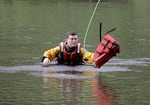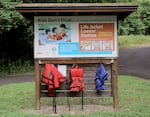
Corbett Fire District's new drone delivers a lifejacket during a training exercise in the Sandy River, May 16, 2025.
Kristian Foden-Vencil / OPB
At Dabney Park in Corbett, a man stands waist high in the middle of the Sandy River. The Corbett Fire Department’s new drone zips into the air, and with the flick of a switch, it drops him a life jacket.
“This new equipment could save lives,” fire captain Jasmine Zimmer-Stucky says. “I want people to realize that this is a wild and scenic river.”
This life jacket drop is a training exercise and the swimmer is fine. But it emphasizes the one thing we can all do to stay safer this summer: Wear a life jacket.
“The water is faster than it looks,” Zimmer-Stucky says. “The water is colder than it looks. There are steep drop-offs. You can get your foot entrapped.”

“The water is faster than it looks. The water is colder than it looks. There are steep drop-offs. You can get your foot entrapped,” said Corbet Fire Captain Jasmine Zimmer-Stucky about the Sandy River, May 16, 2025.
Kristian Foden-Vencil / OPB
Memorial Day marks the unofficial start of summer. But for those in emergency and medical fields, it’s the beginning of a slew of very specific dangers, like drownings, heat stroke and sunburns.
Some less common safety warnings
While “wear a life jacket” is excellent advice, it’s an expected refrain this time of year. But there are some surprisingly uncommon and precarious summer activities.

Life jacket loaner station, Dabney Park, Corbett, May 16, 2025.
Kristian Foden-Vencil / OPB
For example, be careful about just sitting or standing on a log at an Oregon Coast beach. A sneaker wave can lift the log, tip you off, then roll over you.
“People get caught by that every year,” said Matt Hansen, a professor of emergency medicine at OHSU.
While Oregon is blessed with lots of rivers and lakes, they’re largely fed by snowmelt, and swimmers can quickly get in trouble in the cold water.
Related: Cold waters remain dangerous as temps warm across Oregon, officials say
Hansen also advises people to avoid alcohol when swimming and to be especially careful about diving.
“We do see people that will fracture their spines from diving into water where it’s shallower than it needs to be to safely dive,” Hansen said.
There is an uptick in trauma from accidents every summer, especially among children.
Some unexpected hazards include:
- Don’t build a campfire with river rocks. They can explode from thermal shock or trapped gases and send shards and embers flying everywhere
- Make sure to douse fire and embers with water. Not just because it can stop wildfires, but a beach fire swamped with sand alone can burn people’s feet
- Be careful not to get overly enthusiastic about beach digging. A deep sand pit can collapse unexpectedly, and extracting someone takes time. A person buried and starved of oxygen can lose consciousness and suffer brain damage after just one minute
Heat problems
Summer dangers aren’t restricted to water activities.
In 2021, a heat dome settled over Oregon, with temperatures reaching 116 degrees. More than 70 people died in Multnomah County alone. Abe Moland, with the county health department, said it changed the way county staff think about heat.
“Before the heat dome, it was very rare to see heat-associated deaths,” Moland said. “Now, some happen every year. And it’s not expected to get cooler, so we expect this to be an ongoing public health concern.”

Multnomah County says heat effects are cumulative, May 2025.
Multnomah County
Moland said it doesn’t have to be stiflingly hot for trouble to start. Issues can slowly accumulate as temperatures remain high over a period of days.
“Heat builds up in our bodies if we’re not able to cool off,” Moland said. “The longer the heat goes on, the greater the risk of heat-related illness.”
With that in mind, Moland said it’s not enough to simply call a vulnerable family member or friend who may need relief from the heat. Instead, he said people should take action, like bringing someone cool ice water or taking them to a cooling center for a few hours.

Heat safety flyer from NOAA, May 2025.
NOAA
Also, don’t leave children or pets in a parked car. Within an hour, temperatures can reach 110 degrees inside, even if it’s only 70 degrees outside.
Doctors advise staying hydrated, wearing loose, airy clothing, and using sunscreen. Heat stroke symptoms include dehydration, nausea, confusion and in extreme cases, a coma.
Other outdoor hazards
There are a few more summer dangers tangentially related to heat. For example, wearing flip-flops while driving can be a problem. The sole can catch the accelerator or the brake and cause a crash.
Driving barefoot or just walking barefoot is also inadvisable. It can result in injuries from sharps or burns.
And beware the curbside viewpoint area. People seeking the perfect selfie have backed up one too many steps and fallen.
Summer yard work can also result in injuries from mowers and trimmers. And power tools can catapult stones across a yard.
Even eating outdoors can be problematic. From food left in the sun to swallowing a wire bristle left behind by a barbecue brush.
Considering all of these outdoor dangers, camping may seem like the perfect storm for injuries. Especially when adding in things like allergic reactions, Lyme disease from ticks, or West Nile virus from mosquitoes.
But Hansen said it’s good to get outside. Just be careful.
“With sensible precautions, camping is something great.”
Summer hazards at home
All these accidents might also suggest it’s best to stay home.
But summer brings unique indoor problems, too. Eight children a year die falling out of windows in the US.
Hansen said parents open windows to cool the house, and little kids, who tend to be top-heavy already, fall out. They often land head first.
“The parents often don’t even know that it’s happened until a neighbor finds the child on the ground,” Hansen said. “It’s very tragic to see.”
Summer fireworks can also be problematic.
“The demographic tends to be young men, often with alcohol combined, that are doing fireworks, operated in an unsafe way,” Hansen said. “And we see people’s fingers and hands get blown apart every year on the Fourth of July.”
Fireworks cause a lot of eye injuries, too. And they’re not easy to recover from.
Fireworks and other risky activities, like motorbiking, tend to be a problem for younger people in the summer. For the older folks, there is a different nemesis: gravity.
“We see elderly guys doing work on ladders in the spring and summer time, and falling off of ladders and getting seriously injured,” Hansen said.
It may be counterintuitive, but driving can be more hazardous in summer.
Statistically, there are more car accidents in the summer because more people are road-tripping, and there’s more construction.
“We do see people that are impaired from using cell phones or using other distractions while they’re driving,” said Hansen. “Even driving when you’re very fatigued can be dangerous.”
All the usual driving rules still apply.
Wear a seatbelt.
Don’t drink and drive.
Avoid drugs.
Also, don’t ride with your feet up on the dash; that increases the risk of facial fractures or a torn spinal cord.
But apart from all that: Have a great summer.
If taking a dip in a river, be cautious that water temps are still cold enough to pose the risk of hypothermia. Don't let potential for Cascade t-storms ruin your Memorial Day weekend! When lighting campfires, take extra precautions & don't leave embers unattended. #ORWX #WAWX pic.twitter.com/jfqrUveh18
— NWS Portland (@NWSPortland) May 23, 2025
